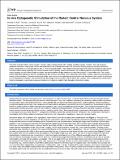| dc.contributor.author | Sidor, Michelle M. | |
| dc.contributor.author | Davidson, Thomas J. | |
| dc.contributor.author | Warden, Melissa R. | |
| dc.contributor.author | Diesseroth, Karl | |
| dc.contributor.author | McClung, Colleen A. | |
| dc.contributor.author | Tye, Kay | |
| dc.date.accessioned | 2015-02-19T16:30:33Z | |
| dc.date.available | 2015-02-19T16:30:33Z | |
| dc.date.issued | 2015-01 | |
| dc.identifier.issn | 1940-087X | |
| dc.identifier.uri | http://hdl.handle.net/1721.1/94634 | |
| dc.description.abstract | The ability to probe defined neural circuits in awake, freely-moving animals with cell-type specificity, spatial precision, and high temporal resolution has been a long sought tool for neuroscientists in the systems-level search for the neural circuitry governing complex behavioral states. Optogenetics is a cutting-edge tool that is revolutionizing the field of neuroscience and represents one of the first systematic approaches to enable causal testing regarding the relation between neural signaling events and behavior. By combining optical and genetic approaches, neural signaling can be bi-directionally controlled through expression of light-sensitive ion channels (opsins) in mammalian cells. The current protocol describes delivery of specific wavelengths of light to opsin-expressing cells in deep brain structures of awake, freely-moving rodents for neural circuit modulation. Theoretical principles of light transmission as an experimental consideration are discussed in the context of performing in vivo optogenetic stimulation. The protocol details the design and construction of both simple and complex laser configurations and describes tethering strategies to permit simultaneous stimulation of multiple animals for high-throughput behavioral testing. | en_US |
| dc.description.sponsorship | National Institutes of Health (U.S.) (Grant MH082876) | en_US |
| dc.description.sponsorship | National Institutes of Health (U.S.) (Grant DA023988) | en_US |
| dc.language.iso | en_US | |
| dc.publisher | MyJoVE Corporation | en_US |
| dc.relation.isversionof | http://dx.doi.org/10.3791/51483 | en_US |
| dc.rights | Article is made available in accordance with the publisher's policy and may be subject to US copyright law. Please refer to the publisher's site for terms of use. | en_US |
| dc.source | MyJoVE Corporation | en_US |
| dc.title | In vivo Optogenetic Stimulation of the Rodent Central Nervous System | en_US |
| dc.type | Article | en_US |
| dc.identifier.citation | Sidor, Michelle M., Thomas J. Davidson, Kay M. Tye, Melissa R. Warden, Karl Diesseroth, and Colleen A. McClung. “In Vivo Optogenetic Stimulation of the Rodent Central Nervous System.” JoVE no. 95 (2015). © 2015 Journal of Visualized Experiments and Leica Microsystems | en_US |
| dc.contributor.department | Massachusetts Institute of Technology. Department of Brain and Cognitive Sciences | en_US |
| dc.contributor.department | Picower Institute for Learning and Memory | en_US |
| dc.contributor.mitauthor | Tye, Kay | en_US |
| dc.relation.journal | Journal of Visualized Experiments | en_US |
| dc.eprint.version | Final published version | en_US |
| dc.type.uri | http://purl.org/eprint/type/JournalArticle | en_US |
| eprint.status | http://purl.org/eprint/status/PeerReviewed | en_US |
| dspace.orderedauthors | Sidor, Michelle M.; Davidson, Thomas J.; Tye, Kay M.; Warden, Melissa R.; Diesseroth, Karl; McClung, Colleen A. | en_US |
| mit.license | PUBLISHER_POLICY | en_US |
| mit.metadata.status | Complete | |
